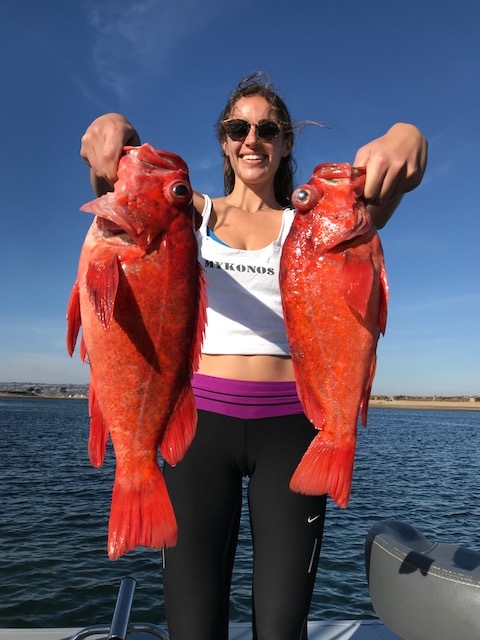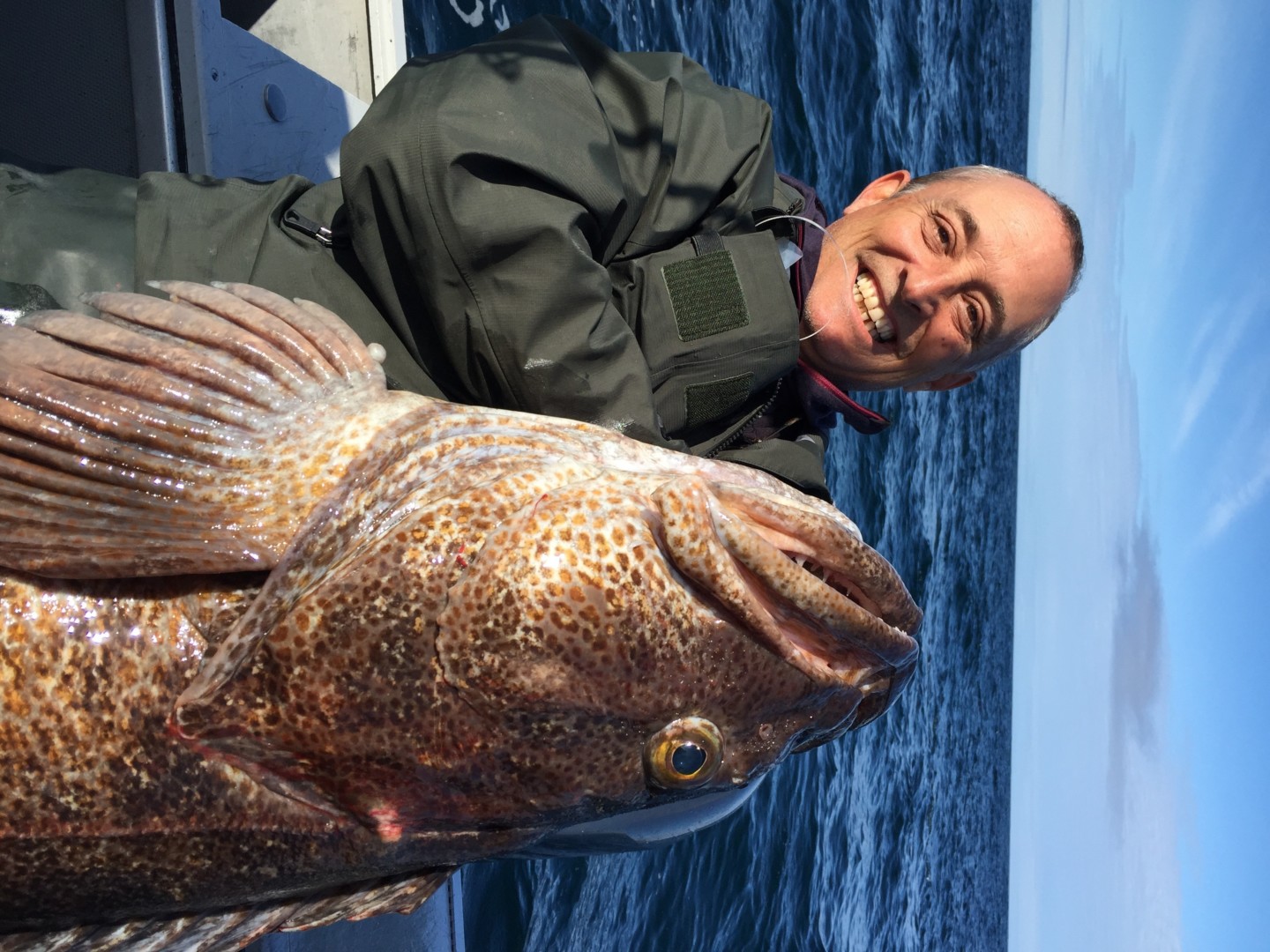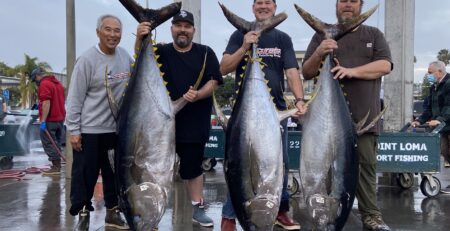West Coast Winter Time fishing
Once October and November roll around in the year the pressure on coastal as well as Island fishing tends to disappear. Many of the anglers look towards the spring-summer months to really get after the gamefish but miss some of the best fishing during the year. Winter time fishing tends to be a little colder but the rewards are pretty good especially when the crowds are non existent.
The Coastal fishing can be amazing dependent on conditions with a variety of fish to target that include Calico bass, Sand bass, Halibut, Rockcod(until December 31st), White Seabass, and until just this year Bluefin Tuna on the outside banks. The fishing along the beach is good.
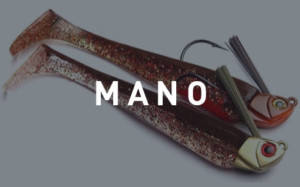
The draw is Calico and Sand bass being the focused catch with an occasional big Halibut, White Seabass caught on plastics or drifting the waters off the beach. The main stay for catching the coastal bass is swimbaits, small jigs, and Hook up baits(tube baits). The hot spots tend to be hard bottom spots that are so conveniently marked by lobster pots in water as shallow as 20 feet to outside spots in 50 to 70 feet. Key to be successful is having a good fish finder on the boat and knowing how to effectively read it. The fish suspend a lot this time of year in groups and by dropping baits into them it will get the competition rolling which will illicit a bite. Watch your line and it will either jump on the way down or stop short of the bottom, and often take off 100 miles per hour. Get your reel into gear and set the hook. With this type of fishing its key to use braid with a little trace leader(12 to 20 inches) of Fluorocarbon line. Looking to have as little stretch as possible which the braid will do and the flouro has very little stretch making it easier to get a solid hookset. Fishing with the braid you will be looking for a more medium action to medium heavy trigger stick rod to compensate for the non stretch in the line. Rod action is important but too heavy of a rod will work against you. Reel of choice will be a bigger bait caster so you can react quickly by being able to go in and out of gear quickly once you feel the slightest pressure. The key is to be able to react to anything that is different as mentioned above. Remember with artificial baits, if you think you are bit wind and swing. Trying to out feel a fish on the end of your line is a tough thing to do and swings are free. Remember often when fishing the bottom, you put your reel into gear and feel a solid, consistent weight on your line its more than likely the bottom. Instead of winding tight give yourself some slack line and with your rod swing down towards the water then straight up. By snapping the tip you can often release your lure from rocky haunts without any further headaches. If you are hung up back your boat behind the line in the water. By changing the angle you can can your lure undone.
Coastal inshore fishing pertaining to artificial lures the best way to stay as weedless as possible is to use Warbait heads which have a plastic barb that protects to the point of the hook but lets a fish pull barbs down exposing the point for a solid hookset. The open hook jigheads will snag more often so its important to under stand the difference between the bottom and a fish. If it pulls back or moves its a fish other wise don’t pull too hard, all you will do is bury the hook and most likely lose a couple bucks that you paid on the lure.
Fishing live bait along the coastal spots is highly effective but also limited to specific spots like deeper rocky outcroppings, kelp edges, and deep water stones. Baits often used will depend on targeted species and their size. Bass fishing is usually anchovies and sardines where yellows will respond will to sardines and mackerels. Size of hook is dictated by the size of the bait and if you are using straight J hooks or circle hooks which is strictly up to the angler. Circles are pretty much pro catch and release where the fish is hooked in the corner of the mouth where a J hook might tend to hook a fish deeper. Whatever you have more confidence in and your personal beliefs.
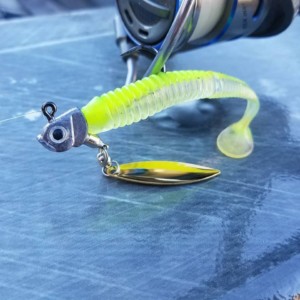
One thing to mention is the bay fishing can be unreal also on artificial baits. You can rent boats in the local harbors line Newport, San Diego bay, Mission bay and have a great time catching Spotted bay bass, Calicos, Sand Bass, Spotfin Croaker, Halibut, and a variety of other fish on light line set ups. Freshwater bass gear does the trick with 6, 8, and 10 lb mono getting the job done. Most of the freshwater lures like spinner baits, mid to deep diving plugs, and a variety of swim baits and grubs really do well. I love fishing under spins which do a bang up job on pretty much all gamefish with a grub or small swim bait attached. Throw it out and let it sink to the bottom and slow wind it back. This lure catches pretty much all species in the bay using 3 or 4″ swim baits in silver, green, red, and chartreuse colors. Want to do something fun with the kids, this is it. Pretty much assured of catching something during the day.
Other types of coastal fishing that is available that we briefly mentioned is halibut and rockcod fishing. 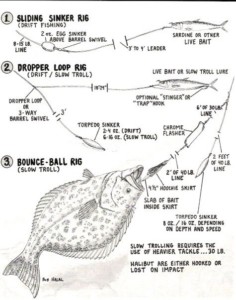 Halibut fishing is done a couple different ways during the winter. These fish tend to congregate in 80 to 140 feet of water over a sand bottom. Some of the better places to look often have stones or smaller rocky structures located in the vicinity. These structures often attract bait and that will keep the food change close. There are two basic ways we fish halibut and the first is just a long drift over these sandy bottoms with sardines, anchovies, or mackerels. Key to success here is fishing the right rig. There are several swivel rigs to use for success that also keep your lines from tangling. I usually put a short 24″ pice of 30 lb mono on my braid then tie to the swivel. There are several rigs shown in illustration included in blog. The weight of the sinker will depend on the depth you are fishing and the speed of the current. Not enough weight means you will be off the bottom lowering your percentages of a bite. Too much weight means it will be more difficult to detect a bite. Important to find that weight that lets the bait drag the bottom yet not too much and doesn’t let the bait come off the bottom. If its right you will be getting bites. No bites revaluate your rig. Most halibut rigs have two smelled hooks rigged on the them. The top one to collar or nose hook the bait and the second hook by the tail as a stinger hook for short bites. These rigs usually have one hook on the bottom that is set and the top hook moves along the leader so you can adjust the length dependent on bait size. You want to have the bait as straight as possible to avoid any spinning that can create a tangle.
Halibut fishing is done a couple different ways during the winter. These fish tend to congregate in 80 to 140 feet of water over a sand bottom. Some of the better places to look often have stones or smaller rocky structures located in the vicinity. These structures often attract bait and that will keep the food change close. There are two basic ways we fish halibut and the first is just a long drift over these sandy bottoms with sardines, anchovies, or mackerels. Key to success here is fishing the right rig. There are several swivel rigs to use for success that also keep your lines from tangling. I usually put a short 24″ pice of 30 lb mono on my braid then tie to the swivel. There are several rigs shown in illustration included in blog. The weight of the sinker will depend on the depth you are fishing and the speed of the current. Not enough weight means you will be off the bottom lowering your percentages of a bite. Too much weight means it will be more difficult to detect a bite. Important to find that weight that lets the bait drag the bottom yet not too much and doesn’t let the bait come off the bottom. If its right you will be getting bites. No bites revaluate your rig. Most halibut rigs have two smelled hooks rigged on the them. The top one to collar or nose hook the bait and the second hook by the tail as a stinger hook for short bites. These rigs usually have one hook on the bottom that is set and the top hook moves along the leader so you can adjust the length dependent on bait size. You want to have the bait as straight as possible to avoid any spinning that can create a tangle.
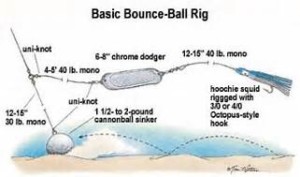 (Check out illustration) The other rig used for halibut is a bounce ball rig that produces more bites because it covers move area since you are slow trolling. With this technique you are using a heavier round ball that is in contact with the bottom and a lure that is 24 – 30″ behind the ball. A medium action rod with a 500 size conventional reel with a clicker is key. We use 50 t0 65lb mono tied to a 30 to 40 lb monofilament top shot. The illustration will give you exact rigging but you can use a hoochee that is shown or a deep diving crank bait, either one is effective but the Deep diver really produces the reaction strike. As the ball sinker drags along the bottom it creates disturbance which gets the halibuts attention as they look at the ball a lure comes right by them creating the opportunity. Like the first technique, the amount of weight used is critical to make sure you are contacting the bottom. Usually we troll at a slower speed and if traveling with current the motor is in and out of gear. Going against the current you will stay in gear depending on the speed of the current. Watching the rod tip is critical to detect short bites. If you get a fish that gets it all he buries the hooks himself. I often have my trails function on my fish meter when I am trolling so I can back tract my steps especially if I find an area that produces bites. Most likely you will have the same success staying in the area since these gamefish gather in areas holding bait with the right conditions. Another good piece of equipment to have on board is a long handle net with a larger circular opening. Gaffs are predominantly used but the net is more effective for those not frequently sticking active fish.
(Check out illustration) The other rig used for halibut is a bounce ball rig that produces more bites because it covers move area since you are slow trolling. With this technique you are using a heavier round ball that is in contact with the bottom and a lure that is 24 – 30″ behind the ball. A medium action rod with a 500 size conventional reel with a clicker is key. We use 50 t0 65lb mono tied to a 30 to 40 lb monofilament top shot. The illustration will give you exact rigging but you can use a hoochee that is shown or a deep diving crank bait, either one is effective but the Deep diver really produces the reaction strike. As the ball sinker drags along the bottom it creates disturbance which gets the halibuts attention as they look at the ball a lure comes right by them creating the opportunity. Like the first technique, the amount of weight used is critical to make sure you are contacting the bottom. Usually we troll at a slower speed and if traveling with current the motor is in and out of gear. Going against the current you will stay in gear depending on the speed of the current. Watching the rod tip is critical to detect short bites. If you get a fish that gets it all he buries the hooks himself. I often have my trails function on my fish meter when I am trolling so I can back tract my steps especially if I find an area that produces bites. Most likely you will have the same success staying in the area since these gamefish gather in areas holding bait with the right conditions. Another good piece of equipment to have on board is a long handle net with a larger circular opening. Gaffs are predominantly used but the net is more effective for those not frequently sticking active fish.

The other type of coastal fishing that anglers should be aware of until December 31st each year is shallow water rock fish. People talk about red snapper being a table fare delicacy, well that is basically our rockfish. Most of this fishing is done between 80(NorCal) to 240 feet of water but there is a lot of area on the coast in the 140 to 160 foot depth that produces quality fish. The targeted fish include reds and a variety other red denizens of the deep. We often are able to put a lingcod or two on the deck which is the premiere eating fish. As for catching these gamefish both bait and artificial work great. Bait wise guys are using dropper loop rigs with single or multiple hooks spaced apart to avoid tangles with a sinker on the bottom of the rig as illustrated in diagram above. The baits can be squid when available either whole or strips, Sardines, or anchovies. As for artificial baits, anglers use metal jigs, plastic swimbaits, and most recently Hook up baits on smaller setups with braid and a short trace leader. Key with any of this deep water stuff is to have enough weight on the rig so as you drift you are able to stay near the bottom. If you do not have enough weight the lure or rig will trail the boat putting an angle between you and your bait which pulls the lure or bait rig up off the bottom and out of the zone. Make sure you have enough weight to compensate for drift speed and depth fishing. This is critical for success in deepwater fishing no matter where you are.
These are some for the fisheries that exist on the west coast during the winter without crowds. You need to look into the regulations on the rockfish, season, and know the slot sizes and limits on the other species. We hope you enjoy your time on the water. Stay safe and sane in 2018.
Wishing you a Happy New Years.
Team Accurate
 Custom Color Reels
Custom Color Reels
